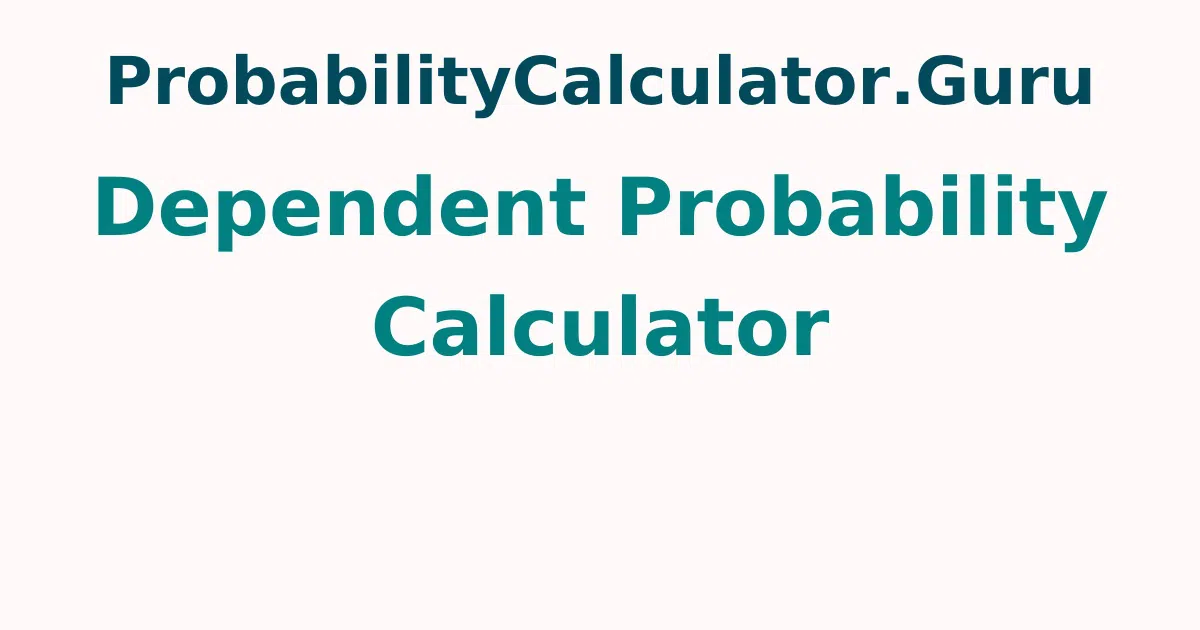Dependent Probability Calculator
Created By : Vaibhavi Kumari
Reviewed By : Rajashekhar Valipishetty
Last Updated : Mar 22, 2023
Take the help of the Dependent Probability Calculator to determine the probability of two dependent events easily. Provide probabilities of the two dependent events and press the calculate button to check their probability using conditional probability formula.
What are Dependent Events?
If the outcome of one event depends on the outcome of another event, then those events are called dependent events. The example is Rio scored well in the physics exam because she studied for it. You can use the conditional probability formula to find the dependent probability.
How to Calculate Dependent Probability ?
Go through the below steps to find the dependent probability of two events. You will find the detailed explanation provided here of extreme help to solve the probability of dependent events.
- Get the compound probability of an event and any one dependent probability.
- Divide the compound probability by the known event probability.
- The value is called the dependent probability.
Conditional Probability Formula
Conditional probability is defined as the probability of one event that has occurred in connection with one or more events. If A and B are two events, then the conditional probability of events A, B is given as:
P(A|B) = P(A∩B)/P(B), P(B)>0
The conditional probability of B, A is P(B|A) = P(A∩B)/P(A), P(A)>0
Assume that A and B are two dependent events.
If P(A) is the probability of event A, then the probability of event B is P(B after A) = P(B|A)
P (B and A) = P(A) x P(B after A)
Similarly, P(B) is the probability of event B, the probability of A is P(A after B) = P(A|B)
P (A and B) = P(B) x P(A after B)
P(A|B) means the event B has already occurred and it is also called conditional probability of A given B.
Solved Questions on Dependent Events Probability
Question 1: A juggler has seven red, five green, and four blue balls. During his stunt, he accidentally drops a ball and doesn't pick it up. As he continues, another ball falls down. What is the probability that the first ball that was dropped is blue, and the second ball is green?
Solution:
As we know that the first ball is not replaced by the juggler. So after dropping the first ball, he is left with 15 balls.
The probability that the first ball is blue is P(blue ball) = 4/16
The probability that the second ball is green is P(green ball) = 5/15
The probability that the first ball is blue and second ball is green is P(blue than green) = P(blue) x P(green)
= 4/16 x 5/15
= 1/12
Therefore, the probability that the first ball is blue and second ball is green is 1/12.
Question 2: Joseph and David are playing a game of cards. Joseph drew a card at random without replacement. He asks David to help him determine the probability that the first card drawn was a queen and the second is a king.
Solution:
As we understand that this probability is having a dependent event condition.
Probability of drawing queen in the first condition P(queen in first) = 4/52
Probability of drawing king in the second condition after a queen is P(king after queen) = 4/51
P(queen followed by king) = 4/52 x 4/51 = 4/663
Therefore, the probability of drwaing a queen followed by king is 4/663.
Understand various concepts of Probability and its related formulas with ease by referring to multiple tools provided under one roof at Probabilitycalculatorguru.
FAQ's on Dependent Probability Calculator
1. What are the dependent events?
Two events are called dependent events if the outcome of the first event affects the outcome of another event.
2. How to calculate conditional probability on a calculator?
You need to enter the probabilities of both events in the provided input sections and click the calculate button of the calculator. You will get the conditional probability of events as output.
3. What are the differences between independent events and dependent events?
If the occurrence of one event affects the probability of another event, then they are dependent events. The occurrence of one event does not affect other event probability, then those events are called independent events. The dependent events formula is P(A and B) = P(A) x P(B|A). The independent events formula is P(A and B) = P(A) x P(B).
4. What is the formula to find the probability of dependent events?
The probability of two dependent events can be calculated using the conditional probability formula. If A, B are two events, then the conditional probability of A given B is P(A|B) = P(A∩B)/P(B), where P(B)>0. The conditional probability of B given A is P(B|A) = P(A∩B)/P(A), where P(A)>0.
